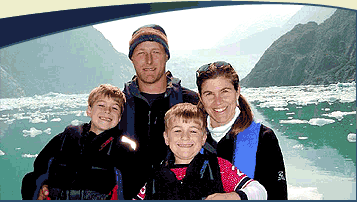 |
Turkey - Turkiye'

A rough start to our time in the Med, we departed the Suez Canal with a terrible intestinal "thing" we can only assume we contracted from the water in Ismailia, Egypt. Closed hauled to the wind for most of the crossing, and only a bleary eye blinking at the radar, we made it safe and sound to the windy haven of Karpathos, Greece. We realize that has nothing to do with Turkey but it was our first stop in the Med. We'll talk about Greece later. From Marmaris to Ephesus, it was all about turkish doner kebabs, turkish rugs, turkish ruins and turkish futball!
Turkiye Turkiye Turkiye! |
|
 |
|
 |
Gullets and Castles |
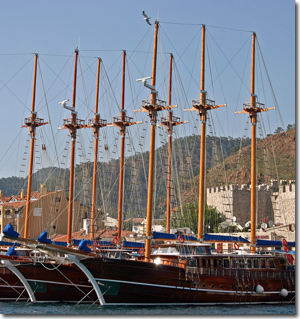
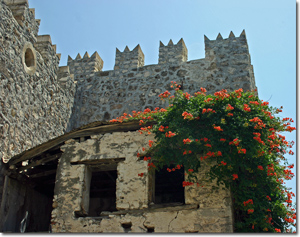
|
|
|
Marmaris
After a quick stint in Karpathos, Greece, we sadly parted company with our pals on s/v Luna and wished them well as they wrapped up their circumnavigation in the Netherlands.
We headed back east, instead, to the safe haven of Marmaris, Turkey. A large and beautiful basin of water nearly entirely surrounded by high rock mountains and covered with pine trees to the waters edge. The northern shore is covered as well by hotels and night life hot spots which helps to give the location it's name of the Turkish Rivera. The tourist industry involves a large fleet of handsome gullets, which are larger than life wooden sail boats that take out large charters groups for day sails and trips around the waters.
We spent a couple of weeks here getting accustomed to the newest foods, kofte, which are like flattened spicy meatballs and doner kebab, much like a gyro. Dolma is a type of stuffed food, such as grape leaves or tomatoes. Funny that the bus system is also named dolmas, as in stuffed as well.
We became quick at handling the more persuasive sales people, be the wares they were peddling, rugs, food, or jewelry. We reunited with the Kelly's, had a spectacular play day at a water park and caught the latest Indiana Jones movie at the theater. Best of all though was the chance to experience the European Soccer Championships through Turkish eye's. They made it as far as the semi-finals, each game down to the last nail biting minutes and sometimes seconds. Every win was better than the last and cause for national celebrations complete with fireworks, all night parades and anthems that would rock you to the core. Pride is an understatement.
|
|
Aegean Coast
With the Kelly's by our side we worked our way up the Aegean coast line. Sailing really earns it's title here. Each morning we would wake up, determining the direction the wind was coming from and attempt to sail directly in to it. It never failed to be the direction we needed to go. Short tacks all the way left our chart plotter looking like a perfect zig zag. Day hops to many different anchorages, each as charming as the last. Each point and prominence also boasts it's own citadel or castle standing firmly rooted there.
One of the best examples was The Castle of St. Peter in Bodrum. Built by the Knights of St. John in union with English, French, German and Italian troops, during the 15th and 16th centuries, the castle itself is still filled with examples of daily life, religious backgrounds and historical battles fought over the lands by each subsequent aggressor. Built over an old acropolis they incorporated the grounds and nearby materials from the Tomb of Mausolus, a governor of Halicarnasus. No coincidence that the common term mausoleum came from his tomb. The Ottoman empire overtook the castle in 1523 and added on their part to make it feel like home, such as the minaret attached to the corner of the church.
Amphoras or the large clay pots used to hold oils, beverages and foods, large vats used for stomping around and crushing grapes into wine or presses and theater masks dating back to the 5th century BC all could be seen. There were examples of various ancient anchors used by ships. The oldest known shipwreck ever discovered on display, showing glass bowls and bottles that sank with a ship in the 14th century BC while trading between Egyptian and Anatolian ports. |
St. Peters Castle |
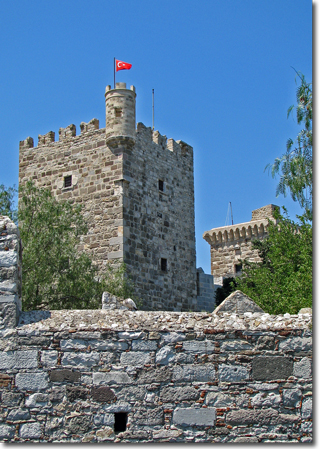
1st Century BC Amphora's
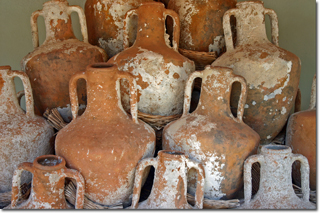
|
|
|
|
Celsus Library
|
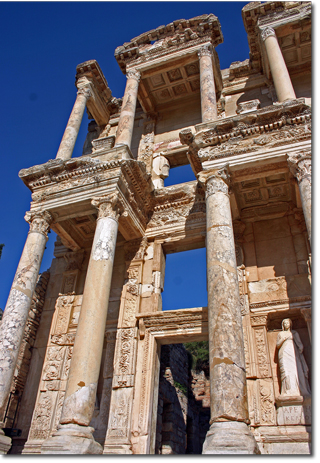
|
|
|
Efesus
A few more short hops and we were to our final Turkish destination, Kusadasi. A nice marina that only had room for us next to the haul out and boat ramp zone. That's worse than having your table next to the kitchen door in the restaurant, but it was perfect for us. A bit far from the showers but close to the ancient site of Efesus, which was all we needed. A rental car are we were well on our way to view the beautiful marble ruins.
Efesus was, in it's heyday, the capital of Roman Asia and the site of a major port for trade. Eventually the Cayster River silted up by 6th century AD, moving it inland by miles. It created marshy swamplands that, teeming with malaria infested mosquitoes caused an epidemic killing 200,000 people, sealing it's fate and losing it's affluent status. What is left behind to view today is still amazing in it's own right by sheer size and preservation. With smaller crowds than you will see in Athens and the more hands on and climb all over approach to viewing the ruins, it is a spectacular place to visit.
|
You can spend a good day wandering the sites here. We'll cover a few favorites.
The Marble street or Kurets at the center of the city, starts at the Prytaneion and ends at the Celsus Library. It is lined with various columns that signified different rulers of the time. Ruts ground in showed how well traveled it was and gaps in the slabs show evidence of a sewer system.
Latrina and skolasitkia bath - the floor was covered by a mosaic of geometric shapes. As with many baths in these days started they contained cold water baths called frigidariums, tepidarium with warm water and finally heated or sauna rooms called kaldarium. The marble floor was situated on round bricks. Hot air would come from a boiler room or stove at the west end and pass through a series of bricks and clay pipes to heat the water and room.
Library of Celsus, one of the most impressive structures still standing tall, once contained 12,000 scrolls and was designed with a special double paneled wall to protect the scroll from fire damage. There was only a small space left in which to build the library to the architects also designed it with lines to create an appearance of greater width.
Grand Theater, 30 by 45 meters held a capacity of 25,000 people, used the elevation of Mount Panayir or Pion for it's structure. The hard marble and sound catching colonnade across the top of the theater proved fantastic acoustics that still ring true during the International Efes Festival each September. |
Hadrian Temple

Grand Theater
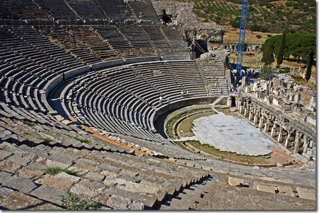
|
|
Sirince
The neighboring towns to Efesus are Sirince and Selcuk, hold little treasure of their own. Our guide took us to a store where you can watch skilled workers weave the traditional and tedious artful Turkish rugs. The double knot is the magic ingredient and every rug salesman, and there are many, will tell you. Similar to the techniques used in Vietnam to harvest the silk threads from the cocoons and dye the threads, the results are every bit as beautiful.
The designs and array of colors are mind boggling. The detail and beauty truly miraculous. Many of the final products are purchased in advanced and will take up to 3 years to finish. The more knots per square inch the more valuable the rug. We had the honor of viewing some with more than 100 knots per inch, each one tied by hand. Better than view them, they cover the floor with them and insist you walk all over them. The boys sprawled out and rolled around on an $80,000 dollar rug!
One last stop brought us to Meryemana, or the last believed home of the Virgin Mary. Brought here by John, Mary lived out her final years and now stands the simple brick building amid lovely pine forests and olive groves. The down side as Matthew aptly put it, " I can't believe they would use this just to make money off of Mary! How wrong is that."
|
|
There is so much more to Turkey than we ever had a chance to cover, the colorful pools of Pamukkale, the cone tops of Cappadocia, Troy and the Trojan horse, the Aya Sofia and all of Istanbul, to name just a few biggies. We surely do hope to go back again some day and see it all if not by boat than certainly by land.
|
|
|
|
 |
|
|
